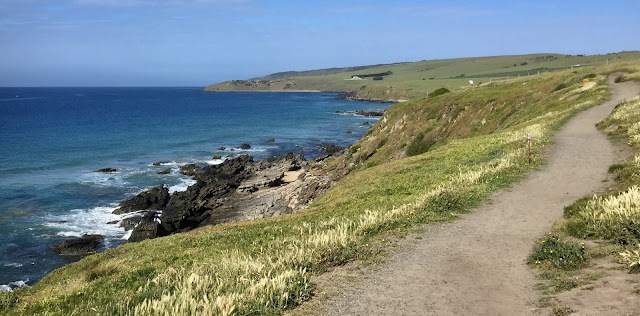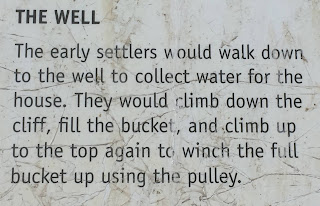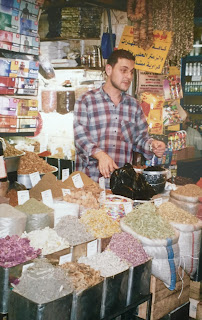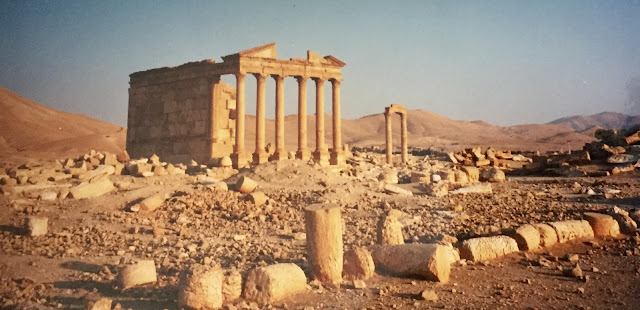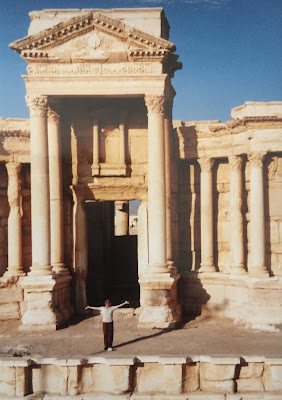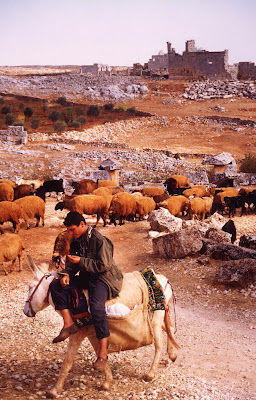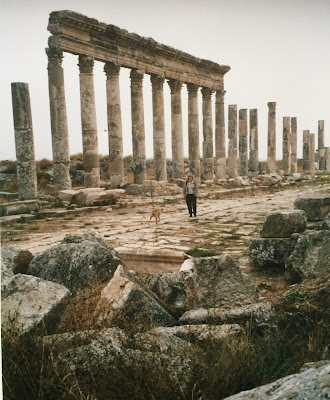Another armchair travel story. The destination this time is Syria which we visited in 2004. We loved every minute of our trip, enjoying the warm hospitality of the people, marvelling at the Biblical landscape, and enthralled by its centuries-old history and culture. How sad it is for us to see what has happened to the country as a result of the civil war, not only to the World Heritage monuments but to the people themselves.
Here is our snapshot of Syria seen in happier times. So sit back and read on - it's a long story. (A note on the photos: the ones I took on film and copied are not quite as vivid and clear as the slides that Steve took and scanned - you'll see the difference.)
We arrived in Damascus late at night after taking a taxi across the border from Amman airport in Jordan; it was dusk, and we could hear the call to prayer hauntingly reaching us from across the desert. I recall feeling excited as we passed signs pointing the way to the 'Dead Sea', 'Aqaba', Saudi border' and 'Iraqi border', this last one making us a bit nervous because the Iraq war was underway.
Damascus, often labelled as the oldest most continuously inhabited city in the world, was a chaotic jumble of noisy, horn-honking, diesel fume-belching taxis and trucks with drivers blending in with one another in a nerve-shattering manner, missing each other by centimetres. The acrid fumes made our throats incredibly sore. The Old Town was just as noisy but people were on foot, jostling one another for space on the narrow roads and footpaths. To cross a road, we would latch on behind a local and shadow them closely until we were safely on the other side.
We visited the famous Damascus souk - cavernous, labyrinthine, crowded, full of the smells of spices and soaps. Stalls displayed rich, brocaded materials, glistening gold jewellery, scrumptious pastries, cows with their heads still dangling from hooks, sheep testicles swimming in fluid, a man using a blow torch over pig trotters (see following photo), gnarled old men pushing carts laden with nuts. It was not touristy at all. Here are some scenes from the souk.
And a quiet section of the Old Town.
We toured the Mosque and saw where John the Baptist's head is reputedly enshrined, plus the tomb of Sal-a-din, the leader of the Saracens defending the Holy Land against the Crusaders.
As a woman, I was made to wear this very flattering heavy brown robe.
We did a fascinating one-day trip out of Damascus to a town called Maalula, 58 kms in the Anti-Lebanon Mountains where Aramaic is still spoken, the language of Christ. Steve had a special interest as his grandfather was an Anglican minister who studied, and could speak, the language. We were extremely lucky to be there on a Sunday and lurked at the back of a church listening in awe to the beautiful language, both spoken and sung. The whole setting seemed very biblical.
 |
| A view of Maalula with its houses embedded in the rock face. |
We then caught a bus to Palmyra, an oasis in the Syrian desert and the site of the ruined ancient city. We couldn't believe that the fare was only $A2 for the 300kms! Palmyra was once a flourishing city on an established caravan route. There was a grand colonnaded main street, temples, a theatre, shops, houses, and further afield, tombs. The Romans held it for a century or so. At the time of our visit it was Syria's most-visited tourist attraction. And then, in 2015 and again in 2017, an extremist group destroyed the main temple, smaller temples, the theatre and damaged the monuments on the Grand Colonnade - spiteful and vengeful acts which the World Heritage organisation is attempting to overturn through restoration.
 But here is what we found in 2004. First up, a sunrise camel tour of the site, the morning sun infusing the ruins with a golden glow. It was so peaceful with not another soul around apart from our guide.
But here is what we found in 2004. First up, a sunrise camel tour of the site, the morning sun infusing the ruins with a golden glow. It was so peaceful with not another soul around apart from our guide.
After the tour we wandered freely around the vast site, marvelling at what once had been the grandeur of this city, and remembering what our guide had told us.
 |
| I believe these four monuments have been destroyed. |
 |
| The theatre in 2004; now severely damaged. |
Of course I couldn't resist...
We visited the nearby tombs; some were underground, others were in towers that we were allowed to enter. Here I am posing (rather glamorously I must say) near a tomb, while in the distance are the ruins of another tower tomb.
 |
| Inspecting a noble's effigy on his tomb. |
 |
| Happy tourists |
We roamed around the nearby town of Tadmor. Here I am at a date stall.
Shopping was a treat; we bargained cheerfully for Bedouin jewellery while sitting on cushions sipping mint tea in tiny glass cups. In the evening we returned to the site for some memorable views.
And then one final photo the next morning.
By a stroke of luck (and very typically Syrian) the owner of our accommodation suggested that we not retrace our steps and return to Damascus by bus and then on to Aleppo as planned. Instead, for $35 each, we could travel with his cousin through the desert and approach Aleppo that way. How could we refuse? It turned out to be the highlight of our holiday. We stopped at a ruined 8th century Arab castle, visited a Bedouin family in their tent, explored a ruined caravan settlement that sits in sifting sand dunes, and crossed the Euphrates River - none of which we would otherwise have experienced.
The Syrian desert
 |
| A minor settlement on the caravan route from Palmyra to the Euphrates. |
 |
| The Bedouin camp we visited. |
The men were out with the animals so it was only the women and children we met. They were so intrigued with us and peppered us with questions (through our guide, seen in the shadowy distance here) such as how old I was, where we were from, did I have children, what did we do.
 |
| The encroaching sand dunes creep up on the ancient settlement of Resafe. |
We eventually arrived in
Aleppo, the cultural capital of Syria. Lots of different nationalities here, especially Armenians. Many people spoke French (Syria had been a French mandate in the 1920s to 40s) and on more than one occasion I had to muster up my vocabulary. It's been a trading post forever so there were lots of souks, bazaars and merchant warehouses (khans).
 |
| In the Aleppo souk |
We chose to stay at Beit Wakil, an 18th restored merchants house. Our room was lined with floor to ceiling timber panelled closets which would have stored the traveller's clothes and other belongings.
The courtyard was filled with lemon and olive trees, jasmine and a fountain.
It was a great place to stay and we dined on mulberries, dates, apricots, mezze, chicken and lamb. A glass or two of arrak (an anise liqueur) sent us spinning. This is cherry chicken, an Aleppo specialty.
The Citadel is the most prominent building in Aleppo and sustained some damage during the war. We spent time exploring the site and admiring the view of the city...
... and marvelling, though not buying, at all the gold shops.
The next day we visited the Baron Hotel, famous for the famous people who stayed there. We were allowed to look into some of the rooms. I sat at the desk where Agatha Christie wrote 'Murder on the Orient Express', while Steve popped into the room where Lawrence of Arabia slept. Fittingly, I had a gin and tonic in the lounge room in a faded old brown leather chair.
We spent the entire following day exploring the Dead Cities on a guided tour - just the two of us. The sites are a collection of former Roman and Byzantine towns that have extensive histories dating from 2500BC and were largely destroyed by earthquakes. Very scenic. Small villages have been established in some, with the ruins interspersed with olive trees, citrus trees, watermelon and fig trees. One town had almost disappeared and is more an archeological dig.
Others were more a collection of ruins...
While at other sites the remains of a town were still clearly visible.
We had a great time exploring and trying to imagine what it would have been like when they were busy and productive towns.
I remember the children who followed us eagerly around. I gave them some Australian 20 and 10 cent pieces, showing them the platypus and lyrebird on them. We look at this photo now and wonder what their future had been.
An interesting side trip was to see what are called bee-hive houses; these were once homes but are now used to store grain and animals. One house had been preserved as a dwelling and we were served lovely mint tea.
On another day-trip we visited Misyaf, an impressively ruined 1140 Assassin castle which sat on a rocky crag above the town.
And then onto the famous Krak des Chevaliers, a vast Crusader castle that was wonderful to explore with its fortifications, chambers, winding stairs, kitchens, vaults and alleys.
Our final stop was Afamia, a once vital trading post on the route to Mecca from Constantinople in the Ottoman Empire and before that, a Roman city. This was our first gloomy day. No sun. Grey clouds. Drizzly rain. An eerie stillness. Perfect for exploring this deserted site. If you look carefully you can see a dog that faithfully stuck to us the whole time we were there - no owner in sight.
We visited the museum which had some wonderfully preserved mosaics that would have graced the Roman villas. Here is an example.
And so ends our tour of Syria - 2004.
We hope that the country will eventually be restored, renewed and returned to its former warm and welcoming self.





